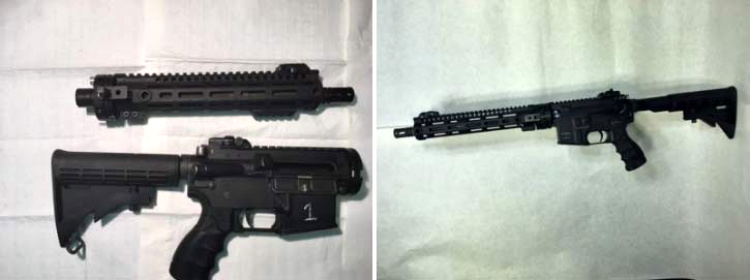Special Operations Community Embraces ‘Wildcat’ Calibers
One phenomenon that has emerged from the U.S. special operations community over the last 10 to 12 years involves exploration and acquisition of small arms in new ballistic calibers.
Rather than the better known weapon designs in 5.56 mm, 7.62 mm, .50 caliber, and even the U.S. Army’s emerging 6.8 mm Next Generation Squad Weapon, the community has embraced calibers like the .300 AAC (Advanced Armament Corporation) Blackout (.300 BLK), 6.5 Creedmoor, .300 PRC (Precision Rifle Cartridge), and both .300 and .338 Norma Magnum.
Often created as so-called “wildcat” rounds, prior to their broader acceptance and expanded production availability, these new caliber cartridges each provide a staggering array of design and performance specifics, experts said.
Recent requests for information released by U.S. Special Operations Command have identified specific command interest in a compact personal defense weapon chambered in .300 BLK.
“We’re dealing in whole different types of mission sets,” explained C.J. Dugan, vice president of business development at Maxim Defense, which has developed its own personal defense weapon designs. “The old way was, if you were doing ‘low vis’ close target reconnaissance or protection, you really only had an MP5 [9×19 mm Parabellum], which is hard to deal with these days because of parts. The only other answers you had were a pistol or a Mk18 [M4A1 (5.56×45 mm NATO) with a Close Quarters Battle Receiver variant with 10.3-inch barrel]. So trying to deal with a weapon system that would give you the right combination of distance and accuracy, and then trying to maneuver in a civilian vehicle with either only a pistol or ‘a 10.3,’ which you then had to keep out of sight, and then deal with and try to react to something, you kind of had limited expectations.”
Crediting the early development work done by Advanced Armament Corp., Dugan offered a general description of the .300 BLK design, which included “taking a 5.56 [mm] case and necking it out to a .30 cal projectile, but utilizing pistol powder inside of that, which gives you a lot of muzzle velocities that you were losing in a short barrel with a rifle round.
“In my opinion, that was the genesis of why the 300 Blackout became popular in the SOF community,” he said. “Because now, with the 300 Blackout — a .30 cal projectile loaded in a 5.56 case and burning pistol powder — you’re now getting 2,000 feet per second out of a five-and-a-half-inch gun.”
“Take a PDW for what it is — a personal defense weapon,” he summarized. “If you are pulling that thing out, things have gone really bad. … And if I am going to make a decision to engage a threat, I want to make sure that I have the best possibility for the terminal ballistics to eliminate that threat. So I combined all of that and we sat down and worked through a product deal with Fort Scott [Munitions], and I took their projectile and we put a bunch of it through our weapons and optimized different calibers for our weapons, both in the five-and-a-half-[inch barrel] and eight-and-a-half variants.”
In addition to its own PDW designs, Maxim Defense has also introduced an ammunition line and is one of more than two dozen U.S. manufacturers that currently produce a .300 BLK option.
Dugan noted that the Maxim .300 BLK is based in part on the “tumble upon impact” designs of Fort Scott Munitions, which continue to “tumble” at ballistic speeds down to 500 feet per second.
Many of Dugan’s observations were echoed by Lanse Padgett, chief executive officer of PCP Tactical LLC and Gorilla Ammunition Co.
“Gorilla Ammunition was established in 2013, and basically was founded on .300 Blackout,” he said. “We started making .300 Blackout right out of the gate, when it was just coming on the scene.”
The company has recently worked with Northrop Grumman, current operators of the government-owned Lake City Army Ammunition Plant, to manufacture “some Blackout loads for military testing.”
Describing the .300 BLK as “a phenomenal cartridge for engagements inside of 200 yards,” Padgett offered, “It is excellent for [close quarters battle]- type operations — room clearing/house clearing/building/clearing — where you can take a short barrel rifle and have almost the same ballistics as a long barrel rifle. But it makes it so much more maneuverable. And you have a much bigger projectile going at the intended target.
“For instance, the 5.56 round was designed for an M16 that had a 20-inch barrel. But now everyone wants to shoot it out of a 10-inch barrel or an eight-inch barrel and you have lost so much velocity by shaving all those inches off your barrels. So you’re now shooting a projectile that was designed to be shot at a certain velocity at much, much less velocity and you don’t have the same terminal effects that you had. … But with .300 Blackout, you’re able to shoot shorter barrels with more lethality. That’s really where I think you gain the advantage.”
Recent SOCOM requests for proposals have also identified interest in weapon designs chambered in 6.5 Creedmoor, with one recent announcement identifying a desire for a lightweight assault machine gun in 6.5 Creedmoor as a possible replacement to the current MK48 assault machine gun chambered in 7.62×51 mm NATO.
Introduced by Hornady Manufacturing Co. around 2007, Padgett said that 6.5 Creedmoor is one of five calibers of polymer cased ammunition currently manufactured by PCP Tactical, along with .50 caliber, .338 Norma Magnum, 7.62×51 mm NATO, “and some work with .260 Remington for the SOF guys.”
It was best to compare the 6.5 Creedmoor to the “traditional” 7.62×51 mm NATO round, he said.
“My ballistician would say this much more eloquently, but basically to get a better ‘ballistic coefficient,’ you want a longer, skinnier projectile,” he explained.
“The 6.5 Creedmoor offers just that in a package that is the same overall length as a .308 (7.62×51 mm) cartridge case. But now you’re getting increased velocity and a better ballistic coefficient, which means you’re going to have increased engagement distance. It’s not going to drop as fast. It’s not going to be affected by wind as much as the traditional 7.62. You’re gaining engagement distance and lethality with the extra benefit that it works in existing 7.62 length chambers. So it’s basically a barrel swap to take existing guns and turn them into 6.5 Creedmoor guns.”
Few programs more clearly reflect the embrace of new calibers better than SOCOM’s acquisitions of bolt-action sniper rifles over the past 10 to 12 years.
An example can be found in its 2009 solicitation for the Precision Sniper Rifle. Planners called for a weapon that could be switched between calibers that would include 7.62×51 mm NATO, .300 Winchester Magnum (Win Mag), and .338 Lapua Magnum. By the time that the subsequent Advanced Sniper Rifle solicitation was released in May of 2018, it specified 7.62×51 mm, .300 Norma Magnum and .338 NM — not the same as .338 Lapua.
It is broadly understood that the .338 NM represents the anti-materiel solution, the .300 NM represents the anti-personnel solution, and the 7.62×51 represents a training option that could also be applied to shorter range urban settings.
In March 2019, Barrett Manufacturing announced that its Multi-Role Adaptive Design system had been selected for the Advanced Sniper Rifle, subsequently designated as the MK22 Mod 0.
The MK22 Mod 0 is one of two Barrett sniper rifles currently being provided to special operations customers. A similar weapon, identified as the “DoD” system, is also being provided to a community element chambered in a Hornady-developed caliber identified as .300 PRC.
“Around November 2016 the Department of Defense issued a procurement for a direct and immediate warfighter capability for the .300 PRC,” said Joel Miller, director of global military sales for Barrett. “It was essentially to provide operators some greater capabilities in stand-off distances and to ensure overmatch.”
Asked about ballistic comparisons between the .300 PRC and the .300 Norma Magnum included on the ASR, Miller deferred to Hornady Manufacturing, which developed the .300 PRC.
According to Neal Emery, senior communications manager for Hornady, all of the other “big 30s” have some type of inherent design issues and the development of the .300 PRC reflected an attempt “to have something that will easily handle the long, heavy, high performance style, .30 caliber bullets with the greatest consistency possible for extended long-range shooting.”
Another long-range projectile that has been embraced by SOCOM over the last few years is the .338 Norma Magnum, with the design of both the .300 NM and .338 NM credited to ballistician Jimmie Sloan in the 2006 to 2007 timeframe.
Community acceptance of the rounds not only contributed to the change in evolution in sniper rifle requirements noted above, but has also been reflected in Special Operations Command — and Marine Corps — interest in belt-fed machine gun designs in .338 NM.
In response, General Dynamics Ordnance and Tactical Systems has been exhibiting its .338 NW Lightweight Medium Machine Gun design for the last few years.
And in January, SIG Sauer announced the safety certification and delivery of a number of its own new “338 MG” systems for special operations combat evaluations.
According to Jason St. John, director of government products in SIG Sauer’s defense strategies group, both the .338 NM and .338 Lapua reflect a sniper community desire for a flatter trajectory, larger bullet, more wind-resistant long-range capability to extend the battlefield for the sniper.
“The .308 [7.62×51 mm] was limited at about 800 meters; 1,000 to 1,200 meters for .300 Win Mag; and they wanted to push it a little bit further,” he said. “That grew into an extended range capability to have standoff with your enemy from an anti-personnel perspective.”
Noting that the .338 NM design results in a 300-grain projectile traveling at 2,900 feet per second, he credited the cartridge with “a tremendous anti-materiel capability” delivered from a 20-pound package.
“The M2A1 [.50 caliber] is an 80-pound machine gun,” he asserted. “We’re looking at a system that’s 60 pounds lighter and actually combines an anti-materiel solution and anti-personnel solution in one trim package.”
He acknowledged “some challenges” in direct comparisons with a .50 cal that has different specialized projectiles, adding, “However, when you’re looking at something like steel penetration with a .338 compared to steel penetration with a .50 cal, they are comparable at 1,200-plus meters, and in some aspects the .338 is superior in mild steel penetration at comparable distances.”
As noted earlier, the representative samples cited here are not intended to serve as complete ballistic profiles. Rather they are intended to highlight the unique characteristics of special operations missions and some of the ballistic overmatch solutions available to Special Operations Forces.

















